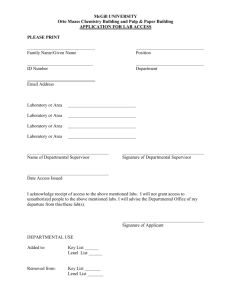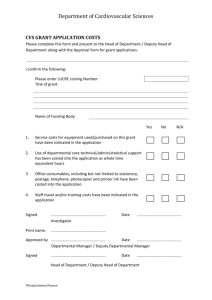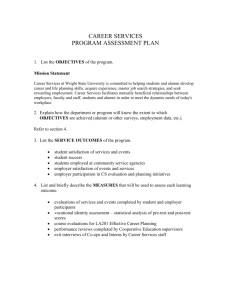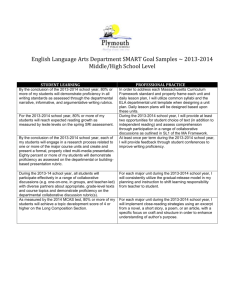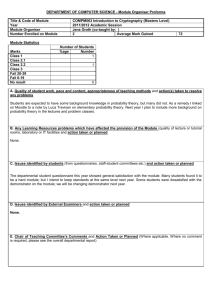Policy Framework – Explanatory Note
advertisement
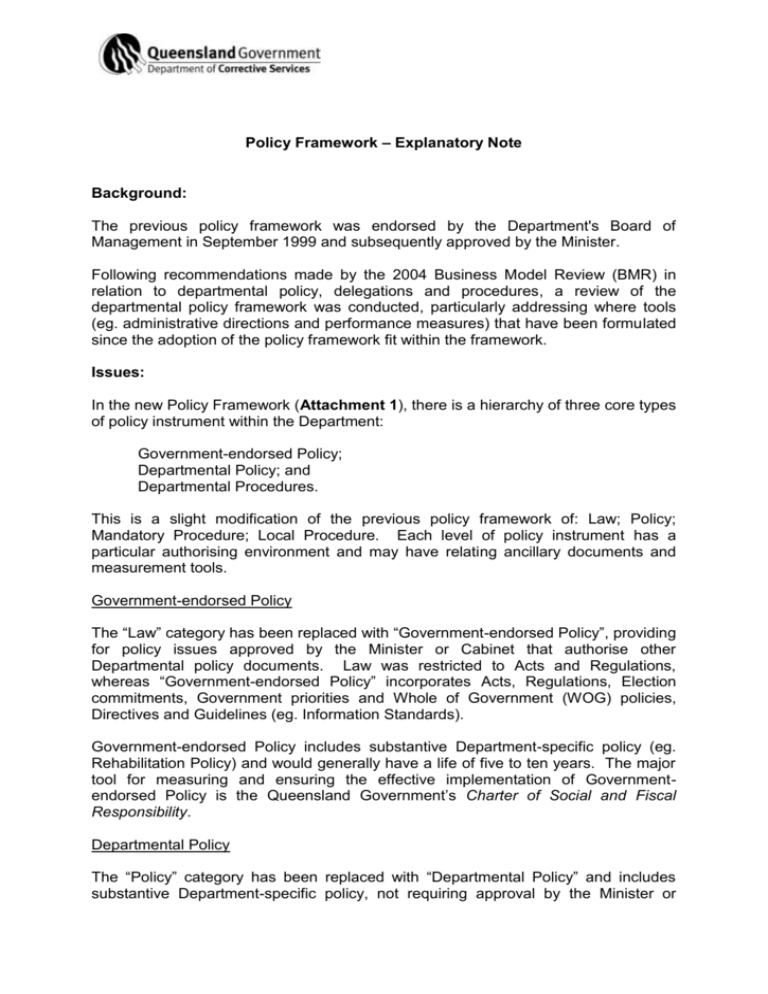
Policy Framework – Explanatory Note Background: The previous policy framework was endorsed by the Department's Board of Management in September 1999 and subsequently approved by the Minister. Following recommendations made by the 2004 Business Model Review (BMR) in relation to departmental policy, delegations and procedures, a review of the departmental policy framework was conducted, particularly addressing where tools (eg. administrative directions and performance measures) that have been formulated since the adoption of the policy framework fit within the framework. Issues: In the new Policy Framework (Attachment 1), there is a hierarchy of three core types of policy instrument within the Department: Government-endorsed Policy; Departmental Policy; and Departmental Procedures. This is a slight modification of the previous policy framework of: Law; Policy; Mandatory Procedure; Local Procedure. Each level of policy instrument has a particular authorising environment and may have relating ancillary documents and measurement tools. Government-endorsed Policy The “Law” category has been replaced with “Government-endorsed Policy”, providing for policy issues approved by the Minister or Cabinet that authorise other Departmental policy documents. Law was restricted to Acts and Regulations, whereas “Government-endorsed Policy” incorporates Acts, Regulations, Election commitments, Government priorities and Whole of Government (WOG) policies, Directives and Guidelines (eg. Information Standards). Government-endorsed Policy includes substantive Department-specific policy (eg. Rehabilitation Policy) and would generally have a life of five to ten years. The major tool for measuring and ensuring the effective implementation of Governmentendorsed Policy is the Queensland Government’s Charter of Social and Fiscal Responsibility. Departmental Policy The “Policy” category has been replaced with “Departmental Policy” and includes substantive Department-specific policy, not requiring approval by the Minister or 2 Cabinet, but which generally refers to relevant authorising “Government-endorsed Policy”. Departmental Policy would generally have a life of four years (corresponding to the life of the Strategic Plan). The major tool for measuring and ensuring the effective implementation of Departmental Policy is the Department’s Strategic Plan, supported by the monthly scorecard and quarterly Board of Management (BOM) Report. Consistent with the Corrective Services Act 2000, the Strategic Plan and the 2004 BMR Report, Departmental Policy would be further subcategorised into: Safety and Security; Rehabilitation; Reparation; Criminal and Social Justice; Support Services: and Accountability. Departmental Policy would also include: The Code of Conduct; Delegations, Limitations and Authorisations; Authorisations to engaged service providers; Approved Forms; and Administrative Directions. “Administrative Directions” should only be regarded as temporary or transitional documents that have a life of no more than a year, when they would either expire or be replaced with a specific policy instrument. “Memoranda of Understanding” also sit at Departmental Policy level. As agreements between agencies for implementing policy, such documents are not regarded as policy instruments but as ancillary instruments. Departmental Procedures The “Mandatory Procedures” category has been replaced with “Departmental Procedures”. This category covers all other policy instruments that are at a lower level in the policy hierarchy. Departmental Procedures would generally have a life of four years (corresponding to the life of the Strategic Plan). The major tools for measuring and ensuring the effective implementation of Departmental Procedures are the scorecard, achievement plans and “Accountability Standards”. “Operational Standards”, referred to in the BMR, have been replaced with “Accountability Standards” to give clarity to their function. “Accountability” comes from the range of components (Operational, Support, Accountability) described in the BMR. Accountability Standards are not policy documents, but rather measurement tools to assist with service delivery, management, audit, accountability, performance 3 and benchmarking in relation to the effective implementation of policy. Accountability Standards have application across the Department and private service providers are required to comply with them as a minimum standard. Until now, “Mandatory Procedures” had 13 further subcategories. Such a large number of subcategories made it difficult to find the relevant procedure. To simply the process, the categories have been reduced to four: Offender Management (reflecting the Offender Integrated Management Strategy (IOMS) principles); Safety and Security (incorporating incident management); Support Services (BMR); and Accountability (BMR). Ancillary documents Departmental Procedures have a number of ancillary documents, including appendices, administrative forms and local procedures. Approval of these ancillary documents is delegated to the Executive Director, Strategic Policy and Services. Local procedures will now require an authorising Departmental Procedure. In keeping with departmental principles, local procedures should only contain policy information that is location-specific either due to geography, staffing or budget constraints. Any policy material that has whole of Department application should be contained in a Departmental Procedure and not duplicated in a local procedure. Appendices contain information ancillary to relevant procedures and may take the format of a manual, guideline, example or training material and include prescriptive detail not included in the procedure. An administrative form may also include a checklist. As a general principle material should not be repeated in an ancillary document that is stated in the related, authorising policy instrument. This overcomes the need to change an ancillary document if the authorising document is amended. Accountability Standards The development and approval of Accountability Standards is the responsibility of the relevant directorate and should be consistent with IOMS principles. The directorate must consult with Strategic Policy and Services with respect to risk management and performance issues and the standards must also be compliance checked prior to approval to ensure consistency with departmental policy instruments. Accountability Standards should be brief and complement the related policy instruments. While policy instruments focus on qualitative issues, Accountability Standards address quantity, timeliness and cost factors. The relevant Executive Director must approve Accountability Standards. The Policy and Analysis Branch is responsible for the publication of standards and 4 the management of version control. A risk assessment process would be required to support any proposed amendment to approved standards. Definitions Appended to the policy framework is a series of definitions to ensure consistent meaning is given to various terms across the Department. The definitions situate various terms within the framework and compare terms of a similar type in relation to the hierarchy or level of authority (eg. project, strategy, action plan, manual, guideline). Risk Management The Department will take a risk-based approach to the renewal of policy instruments. The development and review of policy instruments should be collaborative, timely and actively managed. Instruments should be progressively reviewed within the Policy Framework in collaboration with other units within the Department. Internal Audit, Ethical Standards and the Chief Inspector routinely target and review departmental operations. Further, various activities across the Department (such as the implementation of IOMS and the review of Legislation) necessitate review of various policy instruments at particular times. By working collaboratively with these units, Policy and Analysis reduce duplication by targeting areas for review not currently targeted by other units. The Department has established Service Standards to ensure that identified requests for policy change are managed in a timely manner. When the request for policy amendment is made to Strategic Policy and Services, the request must be categorised to assist with prioritisation in order to provide a timely response. Category 1:Priority Requests from the Minister, the Director-General, Board of Management or required by legislation, generally accompanied by a due date. Category 2:Significant Tasks that involve consultation with multiple business units, generally requiring the assigning of a business unit to take the lead in the development of the policy instrument. Category 3:Technical Tasks that involve minimal consultation with business units. The Department’s Partnership Agreement for the delivery of Strategic and Corporate Services to Correctional Operations of June 2005 indicates the relevant unit within the Department responsible for the development or amendment of a policy 5 instrument. The unit with the lead responsibility for the policy instrument must actively manage the progress of the instrument through to the time of its approval. The new framework clarifies the process for the development and review of local procedures and operational standards, which in turn will assist the review of existing policy instruments. For example, existing procedures can be streamlined and become more focused on policy intent and qualitative requirements, resulting in briefer, less cumbersome and easier to navigate documents. Other material may be moved to relevant appendices, local procedures or standards, if required. When a request is made to develop a new policy, the framework can be used to test for the need for the policy and to situate where the policy fits. Questions could include: Who would be required to authorise this document?; What existing policy instruments exist that would authorise this document? (eg. legislation, WOG directives); and Is there a need for the proposed policy (eg. is there a need for a specific departmental application)? On occasions a substantive, stand alone policy document may be appropriate. On other occasions, a short policy statement, placed at the beginning of a departmental procedure, may be all that would be needed to state the policy and to operationalise its intent. Policy instruments are generally published both on the intranet and the internet, unless there is an identified and justified “risk to the security or good order of a corrective services facility” (section 189(3) and (4) of the Corrective Services Act 2000). There are some documents that should not be made available to the public or to all staff that may lie outside the definition of “risk to the security or good order of a corrective services facility”, for example, contingency plans. Such documents are not statements of policy but are more designed to operationalise particular policy decisions. In accordance with the Information Standard 18 – Information Security, such documents would be made available to the public and/or to staff in accordance with the requirements of the applicable category: Public, Unclassified, “X”-InConfidence, Protected or Highly Protected.
